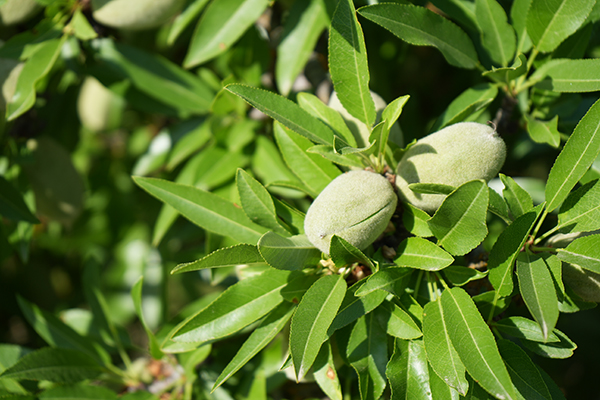
Reimagining Almonds: Transforming a Classic Ingredient into a Platform for Innovation
04 November 2025Chefs are looking to almonds not just for their health halo, but as a dynamic base for formulating richer textures and elevated flavor experiences.
By Ann Rolke, Almond Board of California
Feedback & comments: This email address is being protected from spambots. You need JavaScript enabled to view it.
Almonds are an ingredient and snack culinary students know about but they may not understand its culinary versatility. From sweet and creamy almond butter to smoked almond dust, the fiber- and protein-filled nut will expand your students’ culinary know-how. Almonds also offer instructors an approachable way to build students’ palates with tasting options such as a green unripe almond to a carefully toasted almond to almond milk. Come on an instructional culinary journey that begins in the California fields and ends in the kitchen classroom.
 It’s a fruit tree, really
It’s a fruit tree, really
Biologically, almonds (Prunus amygdalus) are in the peach family. The fruit of the almond tree is a drupe, consisting of a softer outer hull and a hard shell that encases the seed (the almond kernel). While humans don’t eat the outer hull, it does look similar to a green fuzzy peach before it fully matures. Some chefs like to use the immature almond kernels as “green almonds” while they are still somewhat soft and pale. The young almonds can be eaten raw or pickled in salads, soups, and pastas, among other uses.
The health nut
Almonds are one of the world’s most nutritious foods. Over 20 years of research shows that eating almonds can offer an array of benefits to good health. Almonds are an excellent source of vitamin E, magnesium, and riboflavin. They are a good source of fiber and provide 6 grams of protein per ounce.[1]
They are perceived as the most-healthy nut, scoring 8.2 on a 10-point healthfulness scale.[2] That makes them an easy ingredient to add a healthy halo to dishes along with familiar flavors. Since almonds rank as the second most familiar nut to consumers [3], they can add familiar crunch and buttery flavor notes to everything from breakfast pastries to curries and beverages.
Instruct students to safely utilize an allergen
Of course, almonds are a tree nut and are one of the nine major food allergens. Any menu item containing almonds should be properly labeled so it is abundantly clear that the dish contains almonds, whether they’re visible or not. Students should undergo training to understand how to properly provide information to diners on allergens.
One of the best tools to avoid accidental allergen contact is to prevent cross contamination in food prep areas. Many colleges and universities now have separate prep areas for allergen ingredients and signify them with purple-colored cutting boards and signage. Learn more about cross-contact from the Food Allergy Research & Education website.
Trend innovation and versatility with almonds
From crunchy to creamy, almonds deliver flavor and nutrients while offering shelf stability to help food costs. In fact, almonds can have more than two years of shelf life when stored at the recommended conditions.
 With more ingredient forms than any other nut, almonds fit nearly all special diets, including gluten free, dairy free, paleo, keto, and vegan. From the familiar almond milk, whole natural (skin on), and sliced forms to almond flour, meal, butter, and paste, almonds come in ready-to-use forms that save labor.
With more ingredient forms than any other nut, almonds fit nearly all special diets, including gluten free, dairy free, paleo, keto, and vegan. From the familiar almond milk, whole natural (skin on), and sliced forms to almond flour, meal, butter, and paste, almonds come in ready-to-use forms that save labor.
Chef Henry Hill, who works closely with the Almond Board on recipe and product development, says, "The beauty of almonds is in their adaptability, from cold-pressed oil to almond miso to smoked almond dust. In trend-forward cooking, I see almonds less as a garnish and more as a foundation for flavor, protein, texture, and inspiration all in one."
While almond milk is the most popular plant-based beverage, it can also be used as an ingredient in non-dairy recipes as a one-to-one substitute for milk. That gives chefs more flexibility to menu dairy-free creamy soups and sauces, such as the vegan California Almond Parsnip Bisque developed by the University of Massachusetts Amherst Dining team.
Consumers increasingly want protein-packed meals that offer sustained energy and textural elements to increase craveability.[4] Chefs can integrate almonds into dishes to boost protein and fiber, and thus satiation, in a variety of ways:
- Stir almond butter into a Açai Bowl or smoothie

- Roll chicken tenders or fish sticks in almond meal for extra crunch and flavor
- Use almond flour to make gluten-free Crackers with the popular spice blend za’atar
- Combine almond butter, milk, and chopped pieces to make Chef Hill’s Chocolate Almond Butter Rocky Rope
According to the National Restaurant Association, consumers have an increasingly nuanced palate for spice and heat that many Asian dishes deliver.[5] Almonds are a culinary staple in Chinese and Indian cuisines, like this California Almond Aloo Gobi bowl.
Teaching almonds in the classroom
One of the most important flavor techniques for cooking with almonds is toasting. Compare the richness and crunch of a toasted almond and the buttery softness of a green almond. Both are delicious but fit very different applications.
The almond flavor palate effortlessly blends with bold ingredients like Cajun seasonings, mushrooms, brown butter, and black sesame as well as floral fruits, chocolates, and vanilla.
As Chef Hill puts it, "For me, almonds represent balance, they’re timeless yet modern, comforting yet innovative. They fit perfectly into the kind of dishes I love creating, rooted in technique and driven by creativity."
For more techniques on cooking with almonds, watch the Almond Butter Masterclass from Ecole Chocolat or the Creative Applications video from Chef Rob Corliss and visit the Food Professional Hub on the Almond Board website.
World-renowned almonds from the farm to kitchen
Globally, almonds are one of the most popular nuts—enjoyed from China to Germany, India to Mexico. They were mentioned in the Bible’s Book of Numbers (c. 1400 BC) and have been part of many historic customs throughout the centuries. Now, almost 80% of the world’s supply of almonds are grown in California, making them the largest U.S. specialty crop export. California is one of five Mediterranean climates on earth that provides the ideal growing conditions for almonds.
In the past 30 years, California’s almond yield has quadrupled, covering more than half a million acres in the lush San Joaquin, Fresno, and Sacramento valleys. While there are more than 30 different varieties of almonds, only 10 make up a majority of the California crop. Of those, 90% are Nonpareil, California, or Mission varieties. For a visual reference, download a pdf of the Guide to California Almonds.
Every almond tree yields almond kernels (the nuts), shells, hulls (the fruit), and almond wood over a production life of about 25 years. The shells can be used for livestock bedding and are being tested as a source of a non-allergenic nut beverage. The softer hulls can replace alfalfa hay in 20% of animal feed, reducing the acreage needed to grow feed. Almond wood is a popular culinary smoking wood and can also be ground into the soil to further enrich the growth of other trees.
The Almond Board of California is a federal marketing order that represents more than 7,600 almond growers and approximately 100 almond handlers. Amazingly, nearly 70% of the almond orchards are part of family farms of 100 acres or less. That means they’re especially conscious of sustainable growing practices, adopting water-efficient technologies and producing “four crops for every drop.”
Click here to learn more about sustainability practices, the carbon footprint of almond trees, and how farmers are building biodiversity in their orchards.
Sources
[1] USDA Nutrient Database for Standard Reference, Release 28, 2015. All values are based on a one-ounce serving of almonds.
[2] Almond Board of California 2024 Global Perceptions: U.S. (SRG, slide 21)
[3] Almond Board of California 2024 Global Perceptions: U.S. (SRG, slide 12)
[4] Datassential Plant-Forward Opportunity, New Consumer Perspectives on Protein, 2025
[5] National Restaurant Association What’s Hot 2025
